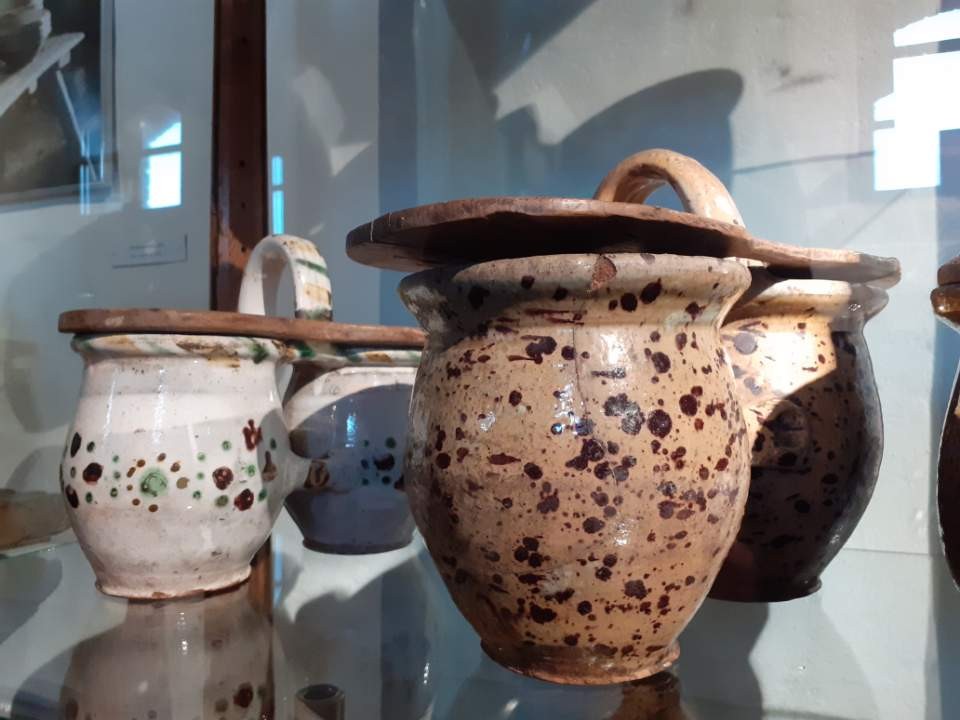The Kwidzyn Castle, a branch of the Castle Museum in Malbork, houses a collection of various types of ceramic vessels originating from the Lower Vistula region. Among them are jugs, whose bellies were coated with dark glaze and decorated with geometric patterns, and the necks and lower edges painted a creamy shade; there are also sieves used by the inhabitants of Żuławy and Vistula, as well as various bottles, bowls, plates, pots, and dwojaki. The latter are particularly interesting, mainly for the function they once served and their ornamentation.
Fans of the painter Józef Chełmoński may be familiar with dwojaki. He captured them in his painting "Storks," which shows a man (father) sitting on a meadow and a boy (son) standing behind him, watching a flock of birds flying over the village. The father is depicted at mealtime, with a vessel for his dinner on his outstretched legs, holding a spoon in his hand. Chełmoński's painting accurately illustrates the dwojaki's function—they were used to carry meals to farmworkers in the fields. One pot would contain soup, while the other usually held potatoes or porridge. Once the parent had eaten, the child could return home with the empty vessel.
The dwojaki from Kwidzyn are clay pots of various sizes connected by latches with finger imprints where they join. A vertically set roller handle connects the pots. The dwojaki with a light brown glaze, decorated with a dark brown speckle pattern, is noticeably bulging and has a wide collar. According to the exhibit's catalog card, this vessel was in use until about 1935. The museum's collection also includes dwojaki decorated with herringbone patterns or dots in repeated layouts. The oldest of these are dated to 1772.
Priest Władysław Łęga, a researcher of Pomeranian culture, particularly that of Vistula, in his extensive work "Ziemia Malborska. Kultura ludowa" published in the 1930s, records that while local people still buy clay vessels from potters in Sztum, Malbork, Prabuty, or Kwidzyn at markets, they are increasingly being replaced by tin alternatives.
Nowadays, dwojaki can be found only in ethnographic exhibits and ceramic shops. They no longer fulfill their original purpose but are instead used to adorn modern kitchens and store various items. To transport meals, trojaki, which are metal pots stacked and clamped together, are now used.
Location: Ryjewo (Kwidzyn district)
Date of creation: around 1775
Author's name: unknown
Characteristic features: dimensions: 16x30 cm, diameter: 15.5 cm; clay twofold, turned on a potter's wheel, with an outer glaze in light brown, decorated with a spray of dark brown dots; the inside of the vessel has a bluish glaze; the vessel served until about 1935 and was owned by a village housewife
Prepared by: Agnieszka Domańska
Special thanks to Ms. Joanna Jezierska from the Laboratory of Archaeology and Ethnography of the Castle Museum in Kwidzyn for the information provided about the exhibit.
Sources:
W. Łęga, "Ziemia Malborska. Kultura Ludowa. Etnograficzne materiały Powiśla i Żuław," Region Publishing House, Gdynia 2018.
http://zamek.kwidzyn.pl/

